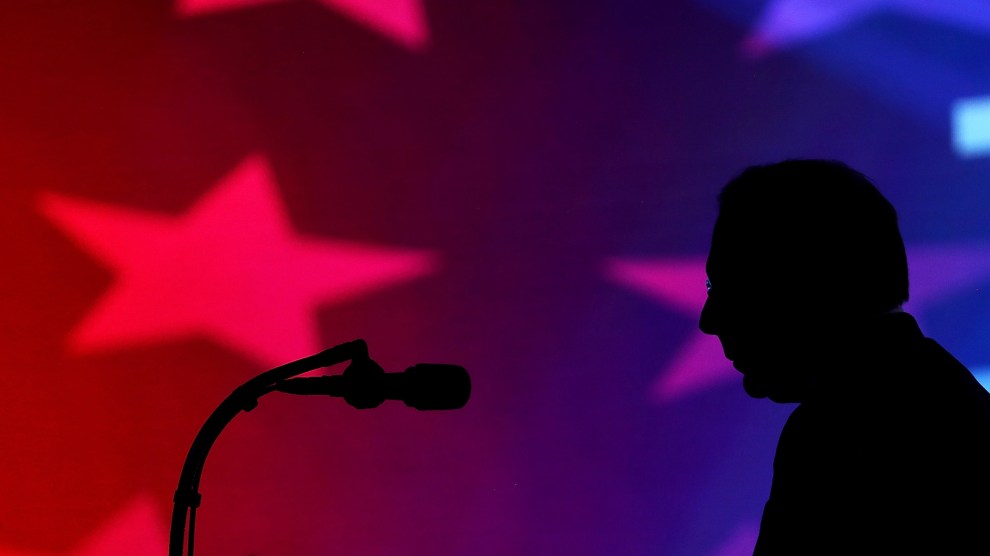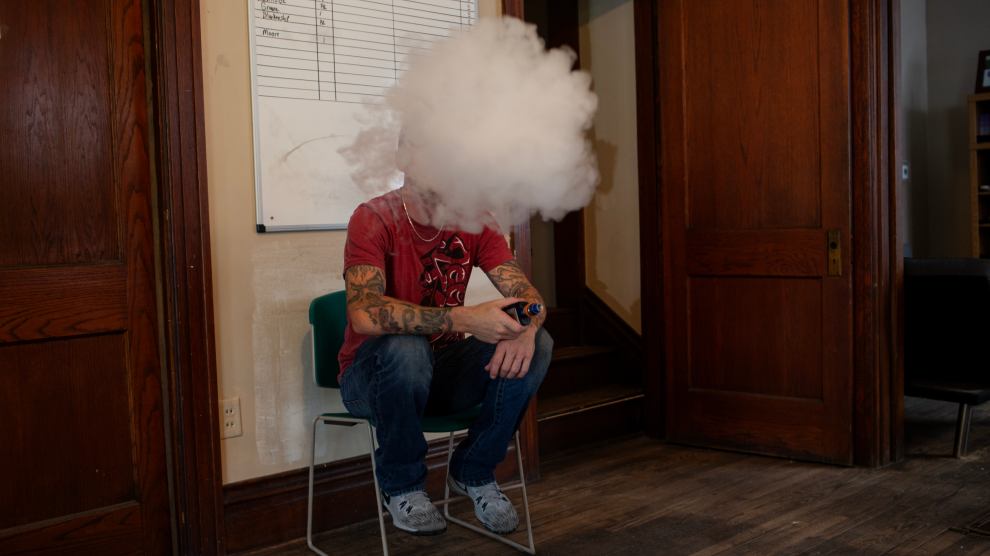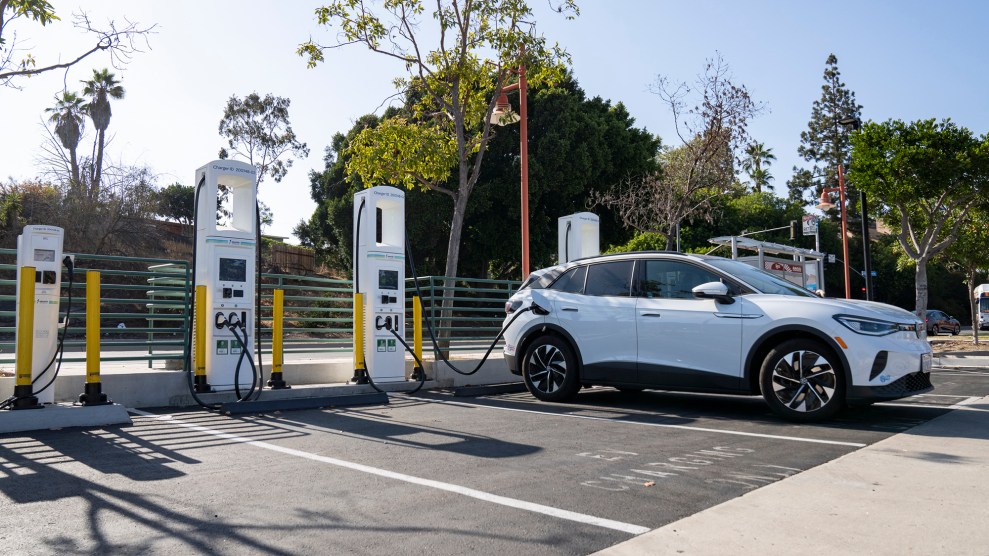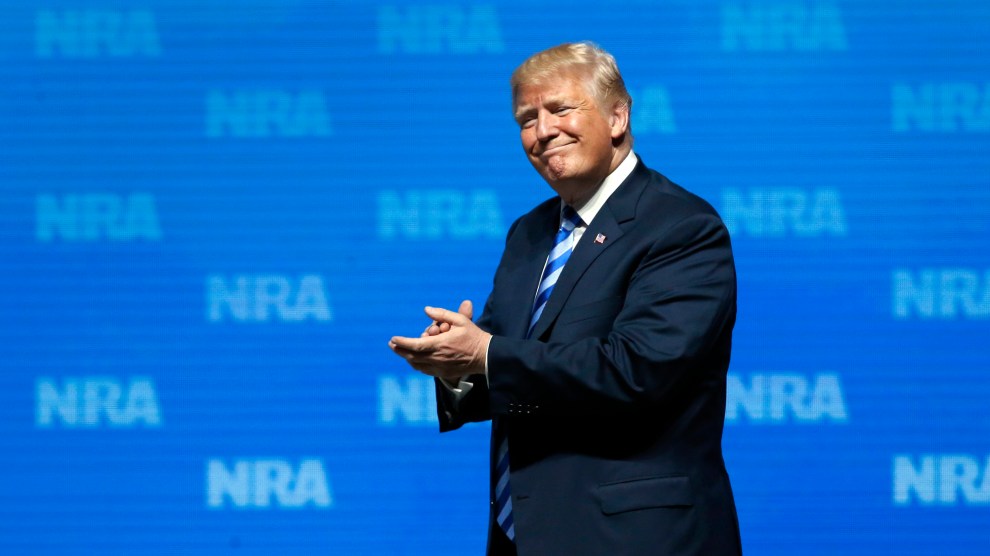
NRA annual convention in Dallas, May 2018Sue Ogrocki/AP
The National Rifle Association spent $30 million to help elect Donald Trump—more than any other independent conservative group. Most of that sum went toward television advertising, but a political message loses its power if it fails to reach the right audience at the right time. For the complex and consequential task of placing ads in key markets across the nation in 2016, the NRA turned to a media strategy firm called Red Eagle Media.
One element of Red Eagle’s work for the NRA involved purchasing a slate of 52 ad slots on WVEC, the ABC affiliate in Norfolk, Virginia, in late October 2016. The ads targeted adults aged 35 to 64 and aired on local news programs and syndicated shows like Jeopardy! and Wheel of Fortune. In paperwork filed with the Federal Communications Commission, Red Eagle described them as “anti-Hillary” and “pro-Trump.”
The Trump campaign pursued a strikingly similar advertising strategy. Shortly after the Red Eagle purchase, as Election Day loomed, it bought 33 ads on the same station, set to air during the same week. The ads, which the campaign purchased through a firm called American Media & Advocacy Group (AMAG), were aimed at precisely the same demographic as the NRA spots, and often ran during the same shows, bombarding Norfolk viewers with complementary messages.
The two purchases may have looked coincidental; Red Eagle and AMAG appear at first glance to be separate firms. But each is closely connected to a major conservative media-consulting firm called National Media Research, Planning and Placement. In fact, the three outfits are so intertwined that both the NRA’s and the Trump campaign’s ad buys were authorized by the same person: National Media’s chief financial officer, Jon Ferrell.
“This is very strong evidence, if not proof, of illegal coordination,” said Larry Noble, a former general counsel for the Federal Election Commission. “This is the heat of the general election, and the same person is acting as an agent for the NRA and the Trump campaign.”
Reporting by The Trace, which has teamed up with Mother Jones to investigate the NRA’s political activity, shows that the NRA and the Trump campaign employed the same operation—at times, the exact same people—to craft and execute their advertising strategies for the 2016 presidential election. The investigation, which involved a review of more than 1,000 pages of Federal Communications Commission and Federal Election Commission documents, found multiple instances in which National Media, through its affiliates Red Eagle and AMAG, executed ad buys for Trump and the NRA that seemed coordinated to enhance each other.
Individuals working for National Media or its affiliated companies either signed or were named in FCC documents, demonstrating that they had knowledge of both the NRA and the Trump campaign’s advertising plans.
Experts say the arrangement appears to violate campaign finance laws.
“I don’t think I’ve ever seen a situation where illegal coordination seems more obvious,” said Ann Ravel, a former chair of the Federal Election Commission, who reviewed the records. “It is so blatant that it doesn’t even seem sloppy. Everyone involved probably just thinks there aren’t going to be any consequences.”
National Media, the NRA, the Trump campaign, and the White House did not respond to multiple requests for comment. AMAG does not appear to have any employees or contacts independent of National Media; a lawyer who has been identified in news accounts as representing AMAG did not respond to multiple requests for comment.
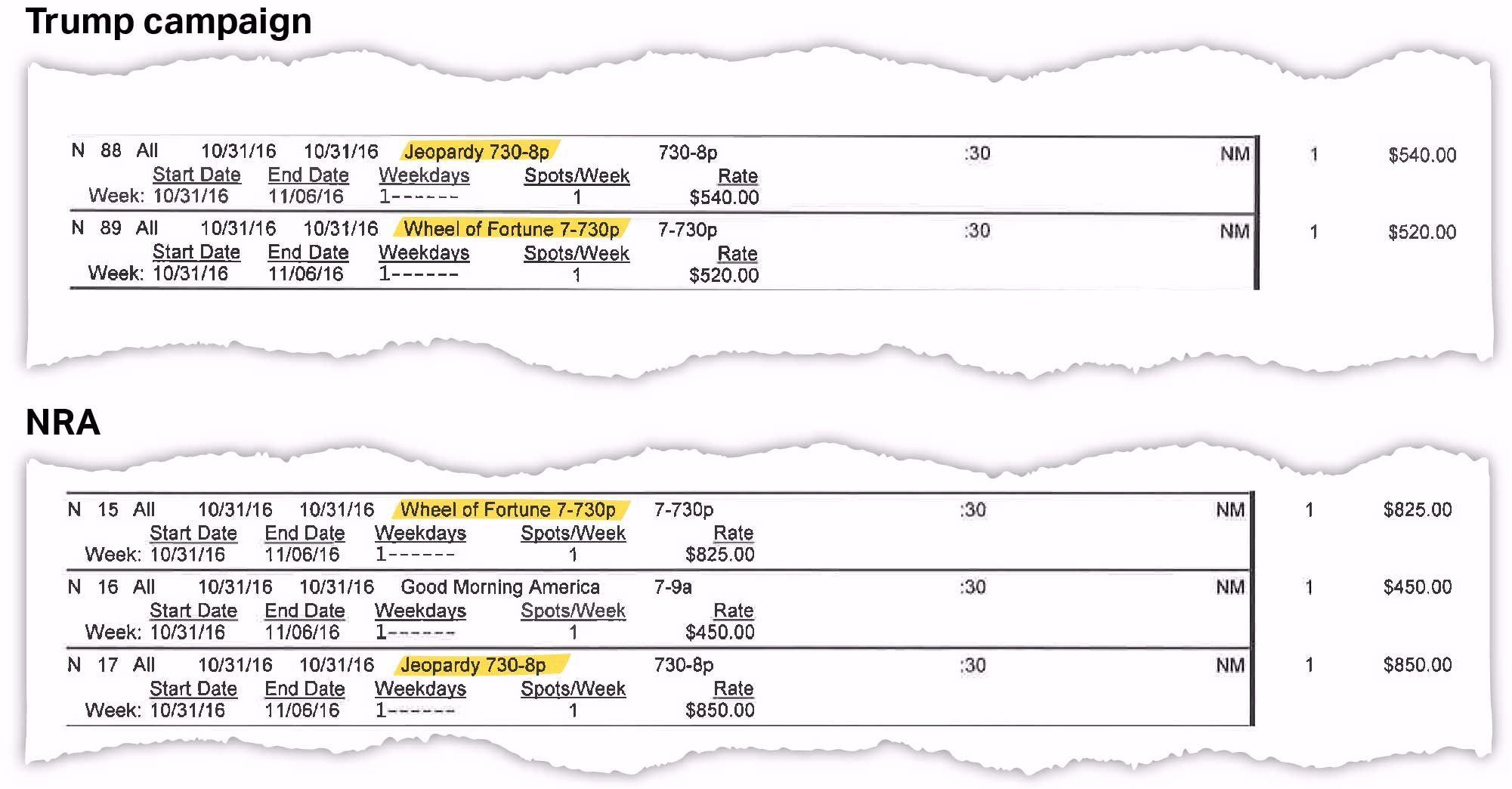
The web site for National Media, which is based in Alexandria, Virginia, describes it as “a nationally recognized leader in media research, planning, and placement for issue advocacy, corporate, and political campaigns,” and says that its “goal is to maximize every dollar that our clients spend on their media.” Those clients have included the Republican National Committee as well as the GOP’s congressional and senatorial campaign committees.
Publicly available corporate documents do not indicate who owns or runs AMAG, but a lawyer representing the company acknowledged to the Daily Beast in 2016 that it was affiliated with National Media. PBS has described AMAG as an “offshoot” of National Media. The Trump campaign paid AMAG more than $74 million for “placed media” in September and October of 2016.
Red Eagle Media, the firm that the NRA used to place its pro-Trump ads, is merely an “assumed or fictitious name” used by National Media, according to corporate records. Corporate, FEC, and FCC records for all three entities list the addresses of 815 Slaters Lane or 817 Slaters Lane, a pair of adjacent brick buildings that share a parking lot in the historic Old Town section of Alexandria.
The NRA was free to spend as much money as it wanted on behalf of Trump in 2016. But under federal election law, if an independent group and a campaign share election-related information, then the group’s expenditures no longer qualify as independent and are instead treated as in-kind donations, subject to a $5,000 limit.
When an outside group and a candidate use the same vendor, staffers working for either client are prevented by law from sharing information with each other. Typically, such vendors make staffers sign a company “firewall” policy, which functions as a pledge not to coordinate and an acknowledgment that there are civil and criminal penalties for doing so. Under the law, National Media staffers working for Trump should have been siloed from those working for the NRA. Documents suggest, instead, a synchronized effort.
Records in the FCC “public inspection files”—files that television stations maintain in order to comply with transparency regulations around political advertising—show that Red Eagle and AMAG often bought ads around the same time, on the same stations, for the NRA and the Trump campaign, respectively. During the last week of October, for instance, Red Eagle bought $36,250 worth of ads on the ABC affiliate in Cleveland on behalf of the NRA. A form the NRA filed with the station described spots mentioning the Second Amendment, Hillary Clinton, Donald Trump, and the 2016 presidential election.
At the same time, AMAG spent almost the exact same amount—$36,150—on a series of Trump campaign ads on the same Cleveland station during the same week. Both the NRA ads and the Trump ads aired during many of the same programs, including local newscasts, Good Morning America, and NCAA football.
We identified at least four current or former National Media employees, including CFO Jon Ferrell, who are named in FCC filings as representatives of both the Trump campaign and the NRA during the final stretch of the 2016 presidential election.
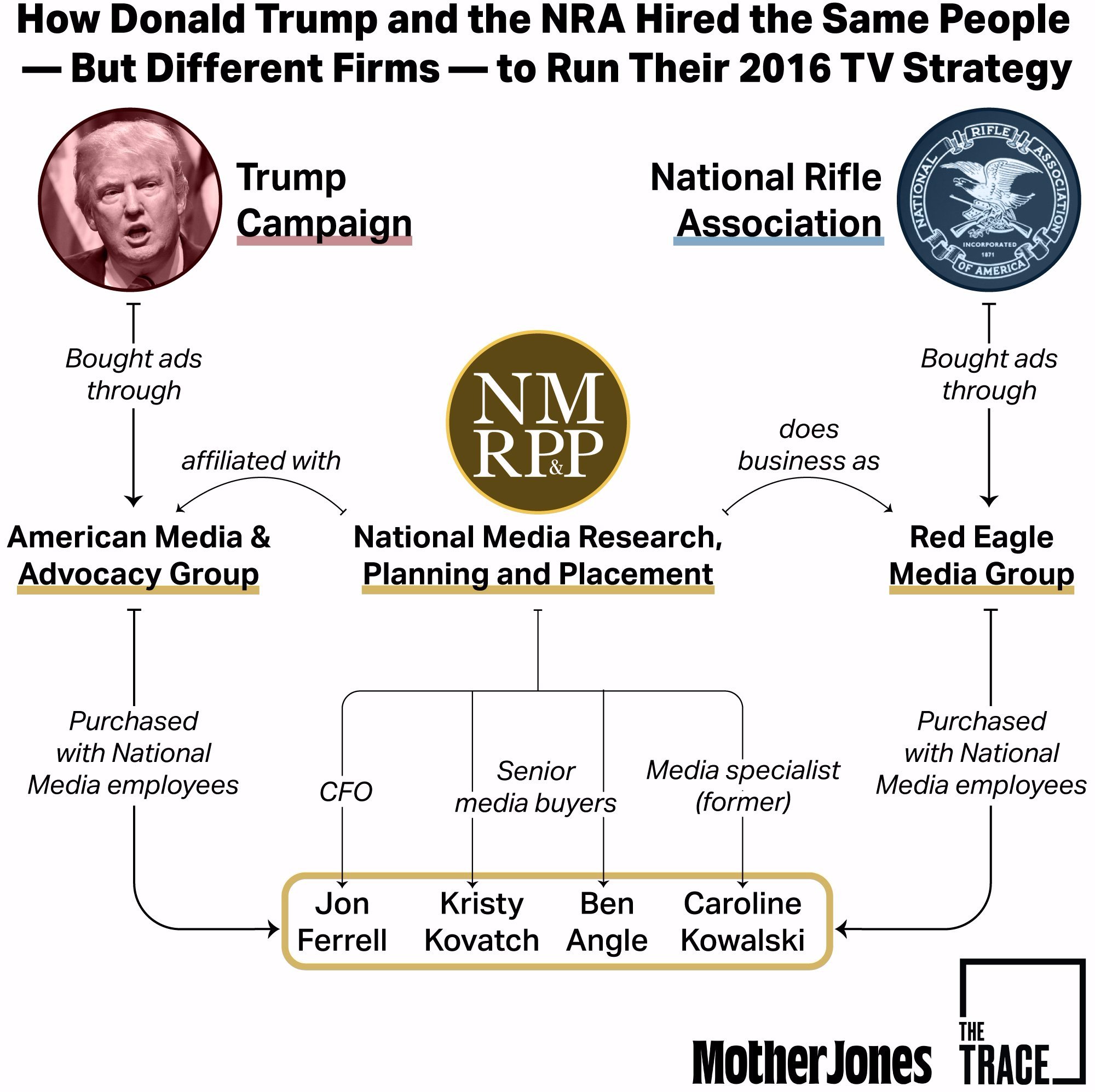
The form filed with the Cleveland station on behalf of the NRA by Red Eagle in September 2016 lists a person named Kristy Kovatch as a point of contact. (An identical form that Red Eagle filed for the NRA with WCPO in Cincinnati also lists Kovatch.) Kovatch is a senior buyer for National Media, specializing in “television media buying for political candidates, issue/advocacy groups and public affairs clients.” According to her bio on the company’s website, she’s been with the firm for 20 years.
Throughout the fall of 2016, Kovatch was also involved in ad purchases for Trump. Just three days before she was named in records as the contact for Red Eagle in Cleveland and Cincinnati, she appeared in the same role on an AMAG advertising request sheet filed for the Trump campaign with an NBC Telemundo station in Miami. FCC documents also list her as the AMAG buyer or contact for various other Florida stations.
Another National Media employee, Ben Angle, was identified in the 2018 book Inside Campaigns: Elections through the Eyes of Political Professionals as an architect of Trump’s airwave strategy. “In mid-September,” the book says, “Angle and his boss were summoned to Trump Tower and told their firm would be placing all of the Trump campaign’s television advertising during the last seven weeks of the campaign.” Angle is listed on National Media’s website as a “senior media buyer.” In October, his name appeared in FCC paperwork as the contact for an NRA ad buy, placed through Red Eagle, at an ABC station in Denver.
A fourth staffer whose name appears on both NRA and Trump campaign documents, Caroline Kowalski, left National Media in 2017. Her title was “media specialist,” according to her LinkedIn page. Within the span of one week in late October and early November 2016, she was listed as the Red Eagle contact for an NRA ad purchase in Cape Coral, Florida, and as the AMAG contact for a Trump campaign placement at a CBS station in Philadelphia.
Ferrell’s signature appeared on forms authorizing ads on stations across the country. For the Trump campaign, that included battleground markets such as Youngstown, Ohio; Cape Coral, Florida; and Reno, Nevada. For the NRA, it included Cincinnati and Wilmington, North Carolina. Ferrell also signed off on placements with national syndicators and distributors covering most of the country for both Trump and the NRA.
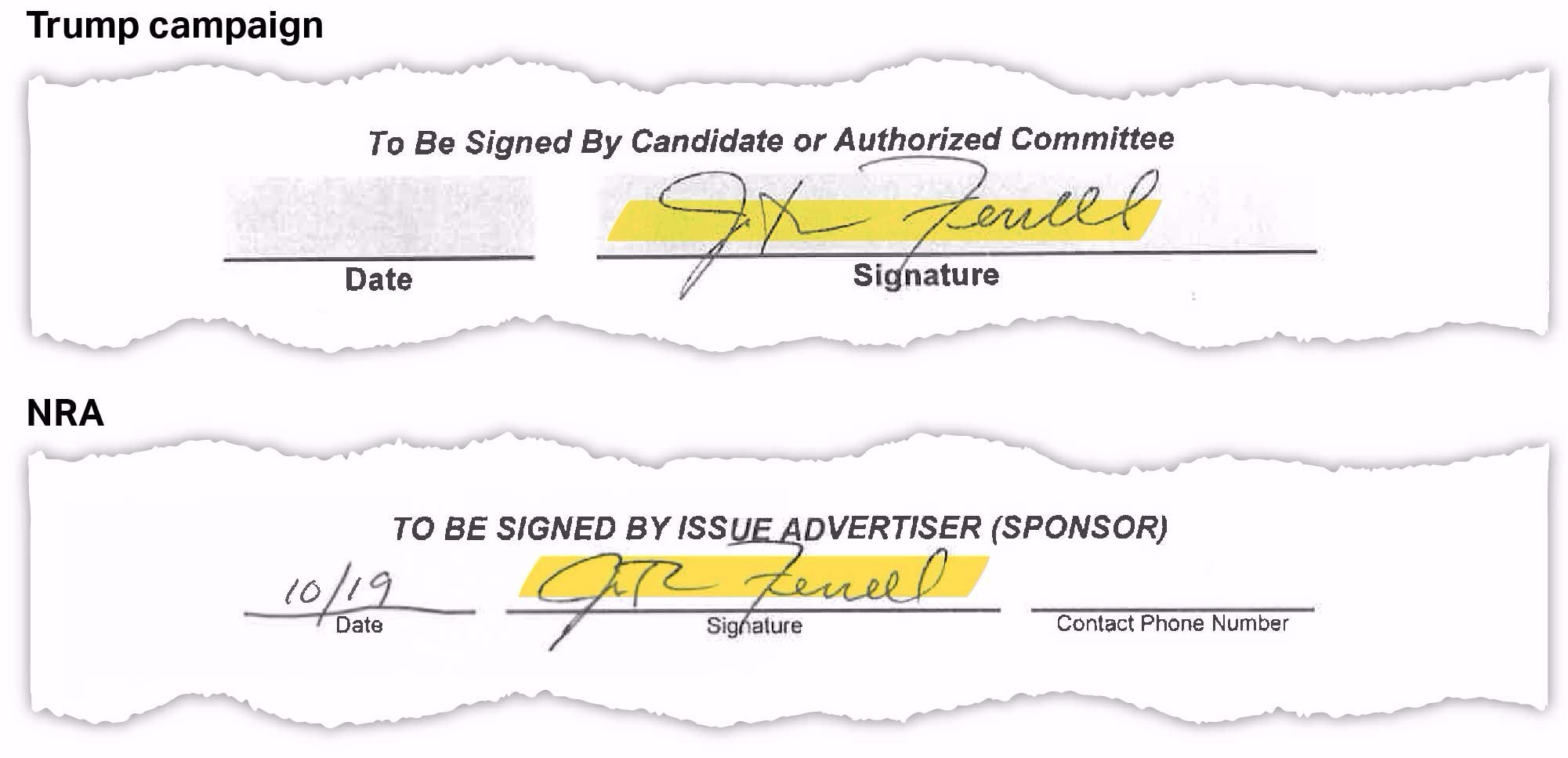
Ferrell, Kovatch, Angle, and Kowalski did not respond to requests for comment. According to their National Media bios or LinkedIn pages, all are specialists in the art of strategic media placement. Ferrell’s “efforts help [National Media] provide optimal financial stewardship of campaign media budgets.” Kovatch “has consistently bought the largest media markets around the country, building an extensive knowledge of ratings, costs and seasonal trends across all time periods and dayparts.” Angle uses his “extensive experience” to “strategically place efficient and effective media buys for our clients.” And Kowalski “acted as a liaison between media buyers and TV, radio, and cable networks,” and “researched voter demographic data to help create” advertising campaigns for, among others, “presidential” candidates and “issue-advocacy groups.”
Prior reporting has identified consulting firms as conduits for potentially illegal coordination between campaigns and outside groups. In 2013, a Center for Public Integrity and NBC News investigation turned up evidence that an AMAG media buyer purchased airtime both for a Texas congressional candidate and for an outside group that was supporting him. In July, we found that the NRA had been using an apparent shell firm called Starboard Strategic Inc. to produce ads for Senate candidates who employed a GOP consulting outfit called OnMessage Inc. The two entities, according to subsequent complaints filed to the FEC, are “functionally indistinguishable.” Starboard and OnMessage are located in the same Alexandria buildings as National Media, according to public records.
The FEC has the authority to launch investigations and seek civil penalties, but it’s unlikely that the NRA or the Trump campaign will face any official action. The FEC’s four commissioners—it is supposed to have six—have been deadlocked for years in an ideological split, making the unanimous vote required for significant investigations almost impossible to achieve. The Department of Justice is also authorized to launch investigations, but prosecutions under the Federal Election Campaign Act are uncommon. If convicted, violators can be subject to criminal fines and up to five years in prison.
Experts say the apparent coordination is the most glaring they’ve ever seen.
“It is impossible for these consultants to have established firewalls in their brains,” Brendan Fischer, the director of the Federal Reform Program at the Campaign Legal Center, said. “We have not previously seen this level of evidence undermining any claim of a firewall.”

Effectively placing ads is among the most important tasks in getting a candidate elected to office. “The creative content is only part of the equation,” said Rick Wilson, a Republican media strategist. “Political advertising relies on smart media placement at every stage. Anything else and you might as well just throw your money in a bonfire.”
Campaign coordination, Wilson added, allows candidates and outside groups to “maximize their resources,” making spending far more efficient. “Modern campaigns are driven by data,” he said. “Pollsters and analytics people will give you a set of targets, and you want to address those targets as best you can, in as many markets as you can.”
Concurrent purchases by Red Eagle and AMAG appear to have been designed to provide such a higher return on spending. On September 15, 2016, for instance, Red Eagle executed an $86,000 deal for the NRA with Raycom Sports Network, a syndicator of sports programs, for slots during seven ACC college football games airing during the final weeks of the presidential race. Documents authorizing the purchase were signed by Ferrell, whose colleague Ben Angle, the senior buyer at National Media, has been a proponent of sports as a way to reach conservative audiences. “Every time we assist a Republican candidate, we advise him to advertise at sports events,” he told one journalist. “In sports, the audience is engaged, they like to see it live so they do not skip the commercials by using a recording device.”
Less than a week later, another National Media staffer authorized virtually the same purchase for Trump. Because stations are required to charge candidates the so-called “lowest unit price” for airtime (while charging independent groups the higher market rate), the deal only cost $30,000.
The purchases were mirror images of each other. In five of the games, both the NRA and Trump bought ads. When the NRA ran two spots either attacking Clinton or promoting Trump, the Trump campaign ran just one. And when the Trump campaign ran two spots, the NRA ran one. The pattern even persisted when there was no direct overlap: In the two games the Trump campaign sat out, the NRA ran two ads. And in the one game during which the NRA didn’t buy time, Trump bought two slots. Side by side, the spots aired across the country on as many as 120 stations, according to data provided by Raycom.
Angle’s name appears on Trump campaign paperwork documenting the Raycom purchase, directly above “AMAG.”
After reviewing the Raycom records, Wilson said the pattern suggests the purchases were part of a unified strategy by the NRA and the Trump campaign. “Sometimes you want to maximize the lowest unit rate on the campaign side,” he said. “But you still need more fire on the target. This is why the FEC says coordination is illegal.”
(Mother Jones and the Trace have teamed up to investigate the NRA’s finances and political activity. See more of our reporting here.)

